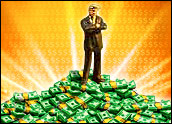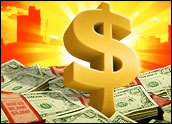
There’s big money in counterfeiting name-brand goods.Sales of knockoff products over the Internet climbed to nearly US$120 billion in 2007, up from $84 billion the previous year, estimated MarkMonitor, an online protection firm that works with eBay and other online auction houses to shut counterfeiters down.
Pirated items run the value gamut from CDs to luxury jewelry. How can consumers tell whether an Internet purchase is a real bargain or an expensive fake? And how can companies protect their valuable brands?
Protections for both consumers and brand holders vary widely from one e-commerce operation to another, MarkMonitor CEO Frederick Felman told the E-Commerce Times. “You have some sites that are on the leading edge in protection, like eBay and others, who have stringent terms of services and deal with huge retailers.”
There is also a sort of Wild West on the Internet, where the danger of fraud is more prevalent.
“Those are places that are truly less controlled — the message-board type places and classified ad places that have less sophisticated protections for those parties,” Felman said. “Purchasing from an unknown seller on one of those less-established places can be problematic for consumers and hard to control for the brand holder.”
Partnering Approach
eBay has some safeguards in place, including its Verified Rights Owners, or VeRO, program. Although no system is perfect, eBay’s is effective, said Nichola Sharpe, an eBay spokesperson.
“Firstly, counterfeit items are illegal, so we don’t allow anything illegal to be sold on the eBay site,” Sharpe told the E-Commerce Times. “It’s not good for our business. Any customer that purchases a [knockoff] on eBay — they’re not going to be happy.”
Hence, VeRO, which eBay launched in 1998.
“Basically, we physically don’t have possession of the items, and we can’t tell, as they get more and more sophisticated, if they’re fake — but Chanel or some other brand holder can,” Sharpe said. “So, we partner with these brand holders.”
eBay has more than 18,000 such partnerships, she added.
“If they look on the site and spot a fake, they can report it, and we take it down,” Sharpe said. “We encourage brands to join the VeRO program; we need their assistance because they’re the experts.”
eBay also works with PayPal to verify purchases and has established volume restrictions on various categories of items sold, which has produced “dramatic results,” she added.
“We take action against [counterfeiters],” Sharpe continued. “Sellers that aren’t adhering to our rules we take off the site, and cooperate with the companies to take action against them.”
eBay invests more than $20 million a year and commits more than 2,000 employees in its efforts to thwart fraud, Sharpe said.
Old Game, New Playbook
Online counterfeiting is nothing new, but its practitioners keep coming up with new tactics.
“It’s been around for years, but it has gotten more sophisticated,” noted Sharpe. “If we find people who possibly are selling counterfeit items, we do everything we can to get them off the site.”
Counterfeiters have developed some slick tricks over the years.
They are extremely savvy and have developed digital technologies that can make counterfeits nearly indistinguishable from a brand’s actual products, Lauren Estrin, an associate in the intellectual property department of Atlanta-based Kilpatrick Stockton, told the E-Commerce Times.
The types of items that are pirated are not limited to technology products like software and DVDs.
“I don’t know what industry is being hit the hardest,” Estrin said. “Fashion, pharmaceuticals, tobacco and, of course, music and different media. I’d say fashion is one of the hardest-hit areas.”
Fashion and luxury goods, such as jewelry, pocketbooks, luggage and clothing items, are highly sought, as “they have the highest price tags,” she noted.
Lawmakers’ Role
The U.S. government has stepped in to help combat the growing problem.
The “Intellectual Property Rights Enforcement Act,” introduced last year by Sens. George Voinovoich, R-Ohio, and Evan Bayh, D-Indiana, is designed in part to improve the management, coordination and effectiveness of domestic and international intellectual property rights enforcement.
“What Congress is trying to do is coordinate with different sectors at every level in different countries around the world to go after counterfeiters at every level of distribution,” Estrin said, noting that such coordination is sorely needed.
“I think this is certainly one of the most aggressive programs we’ve seen so far, in terms of coordination among different government agencies and the private sector,” she pointed out. “But again, it certainly creates a lot more bureaucracy to go through — and a lot will depend on what the international community is willing to do to cooperate with the U.S.”
Mixed Judicial Take
In late June, a French court held eBay responsible for knockoffs sold on the site and ordered the firm to pay $63.2 million.
However, in mid-July, a U.S. federal judge decided in favor of eBay in a lawsuit Tiffany & Co. initiated a couple of years earlier, charging that the online auction house served as a marketplace for counterfeit goods.
Tiffany is appealing that ruling.
Individual Web sites can do only so much, said Roger Kay, principal analyst with Endpoint Technologies.
“Their business is leveraged,” he told the E-Commerce Times. “They’re doing 10 million transactions over the Internet and not over a counter. You literally cannot verify each and every transaction. You don’t know if illegal transactions or state secrets are going through your pipes. You don’t have to know that stuff. I think that’s reasonable, too, because how could you know? People could substitute apples for oranges, and there’s no way to actually police them.”
It’s basically a case off caveat emptor, he continued. “In the U.S., if you can’t verify them, you shouldn’t be buying them.”
If they’re using a classified-ad site such as Craigslist, buyers should shop close to home whenever possible, Felman advised, and be cautious when purchasing items that are represented as top name brands.
It’s better to check out the goods before handing over the cash, he warned. “You might be getting something you didn’t expect it to be.”





















































Social Media
See all Social Media